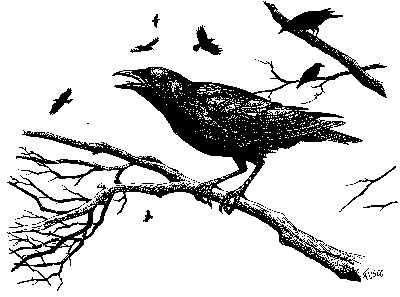American Crow
Corvus brachyrhynchos
Habitat: Forests, towns and agricultural areas
Weight: 20 ounces, on average
Length: 17 to 21 inches
Food: Crows are omnivorous and consume insects, spiders, eggs and nestlings, small mammals, reptiles, amphibians and carrion. They also eat plant material such as seeds, corn, fruit and nuts.
Identification: American crows are large, black perching birds with robust beaks and a fan-shaped tail. Both sexes are alike in appearance, although the females are a little smaller in size. They can be recognized by their familiar call, "caw-caw."
Range: Crows are found throughout central and eastern North America, breeding from Newfoundland west to Manitoba and south to Florida and Texas, and wintering as far north as southern Maine and the Great Lakes region.
Reproduction: In March, crows perform their courtship ritual, which consists of dramatic aerial maneuvers and a dance involving bowing, strutting with spread wings and tail and a general puffing of the feather coat. While dancing, the crows utter a gentle, uncrowlike "rattle" song. This courtship behavior is not often observed. After mating, females spend five to 13 days building a nest in the fork of a tree. The nest is often supported by two or three horizontal branches and constructed six to 60 feet above ground. Males usually assist in its construction. The nest has a crudely built foundation, about two feet wide and nearly a foot thick, and is composed of large sticks and twigs. The nest bowl is built of smaller twigs interwoven with strands of bark and lined with soft tendrils of shredded bark, moss, plant fibers, grass, feathers, wool, fur, rootlets or leaves. The female deposits a clutch of four to six eggs in early April. The eggs may vary in size, shape and color but generally are oval, greenish and blotched with brown and gray. Males feed the females during incubation. After 18 days, the chicks hatch and are tended at the nest for approximately five weeks.
History in Connecticut: In Connecticut, crow populations have increased since the early 1800s due to their high reproductive potential, opportunistic feeding habit and ability to adapt to land-use changes. Forest habitats are adequate for crow survival but agricultural lands and suburbia are even better. The adaptable crow can exploit farming waste and human-generated trash in addition to more natural food sources.
Interesting Facts: American crows belong to the family Corvidae, which includes jays, ravens, nutcrackers and magpies. Crows are very intelligent animals and, if trained, can learn to mimic the human voice and use simple tools to manipulate objects. They have acute senses of sight and hearing and very good memories. They are also fascinated with and will collect shiny objects such as keys, rings and foil.
Crows do prey on young birds and eggs during the spring mating season. They can be very aggressive to other birds and mammals. Crows can sometimes be seen "mobbing" or harassing hawks and owls.
Crows are extremely gregarious birds, flocking together in family units in the summer and congregating in massive (often thousands of birds) roosting units in the fall and winter. Apparently, this group unity imposes demands of regimentation, as ill, injured and old crows are driven from the flock and often killed. Perhaps, because crows function as a group and the safety of the group depends in large measure upon unity and conformity within the group, it becomes important that all function together. Flocks of crows often roost together during the night and then separate to feed during the day. Some birds will visit the same areas each day to feed while others have no apparent routine. Crows often post sentinels while they feed to alert each other to impending dangers.
American crows are partially migratory. In many colder areas of the country, crows will migrate south seasonally. In Connecticut, most crows will remain throughout the winter.
Management of Nuisances: There are a variety of problems associated with crow roosts, primarily when they are in close proximity to people. Commonly, crow roosts are found in stands of mature trees and can be located near homes, buildings, walkways and parking lots. Fecal droppings can accumulate under a crow roost, presenting a health hazard and nuisance by covering cars, walkways and other objects. Another concern is the loud noise associated with thousands of crows.
Some relief from the noise and fecal droppings of crows is possible through disruption techniques such as playing recorded crow distress calls, frightening the crows with noisemakers or a combination of both. Persistence is necessary.
The crow is classified by the U.S. Fish and Wildlife Service as a migratory game bird and state hunting regulations must comply with federal guidelines. In addition to the hunting season, federal guidelines allow crows to be killed if they are "committing or about to commit depredations upon ornamental or shade trees, agricultural crops, livestock or wildlife, or when concentrated in such numbers and manner to constitute a health hazard or other nuisance." Presently, there is no limit on the number of crows that can be taken during the regulated hunting season. For more information, see the current Connecticut Hunting and Trapping Guide.
 The Technical Assistance
Informational Series is 75 percent funded by Federal Aid to Wildlife Restoration -
Pittman-Robertson (P-R) Program. The P-R Program provides funding through an excise tax on
the sale of sporting firearms, ammunition, and archery equipment. The remaining 25 percent
of the funding is matched by the Connecticut Wildlife Division. (rev. 12/99)
The Technical Assistance
Informational Series is 75 percent funded by Federal Aid to Wildlife Restoration -
Pittman-Robertson (P-R) Program. The P-R Program provides funding through an excise tax on
the sale of sporting firearms, ammunition, and archery equipment. The remaining 25 percent
of the funding is matched by the Connecticut Wildlife Division. (rev. 12/99)

